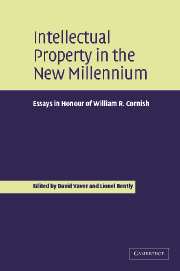Book contents
- Frontmatter
- Contents
- List of contributors
- Foreword
- Preface
- General intellectual property
- Patents and plant protection
- 5 Creating the community patent and its court
- 6 Patents – what's invention got to do with it?
- 7 Common law and civil law approaches to patent claim interpretation: ‘fence posts’ and ‘sign posts’
- 8 Indirect infringement of patents in Israel: judge-made law
- 9 Genomics and the food industry: outlook from an intellectual property perspective
- 10 From ‘outmoded impediment’ to global player: the evolution of plant variety rights
- Trade marks and unfair competition
- Copyright, moral and neighbouring rights
- William R. Cornish – curriculum vitae
- Index
5 - Creating the community patent and its court
Published online by Cambridge University Press: 25 May 2010
- Frontmatter
- Contents
- List of contributors
- Foreword
- Preface
- General intellectual property
- Patents and plant protection
- 5 Creating the community patent and its court
- 6 Patents – what's invention got to do with it?
- 7 Common law and civil law approaches to patent claim interpretation: ‘fence posts’ and ‘sign posts’
- 8 Indirect infringement of patents in Israel: judge-made law
- 9 Genomics and the food industry: outlook from an intellectual property perspective
- 10 From ‘outmoded impediment’ to global player: the evolution of plant variety rights
- Trade marks and unfair competition
- Copyright, moral and neighbouring rights
- William R. Cornish – curriculum vitae
- Index
Summary
What I am going to do is to start at the beginning, skim the middle, and talk about where we are now.
The beginning – 1962
Amongst my late father's papers I found a little (just over A5 size) booklet with a fading green outer cover. It was published by Her Majesty's Stationery Office in 1962 and the price was five shillings. It is entitled Translation of a Draft Convention relating to a European Patent Law. The original document was prepared by a committee of representatives of the six members of the EEC. The draft said that ‘European patents’ shall have a unitary and autonomous character, that they shall have effect in the territory of all Contracting States, and should be subject only to the provisions of the Convention.
So the idea of a proper European Patent is very old – going back to the time before I, at least, had only the faintest idea about patents at all. Many people now involved in patents were not even born. It was a time when the phrase ‘intellectual property’ was unknown to all but a few specialists – and to those few, it meant copyright and like rights only. It was a time when there was very little intellectual property litigation.
- Type
- Chapter
- Information
- Intellectual Property in the New MillenniumEssays in Honour of William R. Cornish, pp. 79 - 90Publisher: Cambridge University PressPrint publication year: 2004

